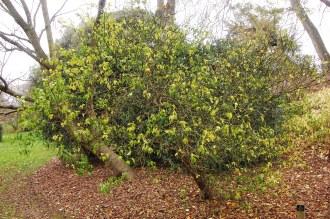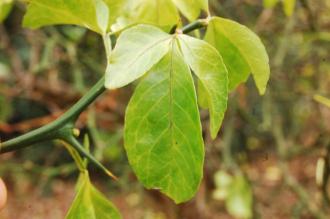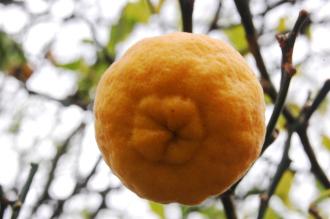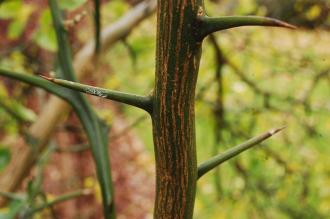
Poncirus trifoliata (07/12/2015, Kew Gardens, London)
Position: Full sun, to light shade
Flowering period: Spring
Soil: Moist, well drained
Eventual Height: 7m
Eventual Spread: 6m
Hardiness: 6a, 6b, 7a, 7b, 8a, 8b, 9a, 9b
Family: Rutaceae

Poncirus trifoliata Autumn Leaf (07/12/2015, Kew Gardens, London)
Poncirus trifoliata is a deciduous large shrub or small tree with a rounded habit. Its dark green leaves are trifoliate, each leaflet being elliptic with entire margins, the center leaflet being up to 5cm long and 2.5cm across. Its leaves turn yellow in autumn before they fall. Its branches have sharp thorns which are up to 5cm long. Its slightly fragrant white flowers are waxy and up to 5cm across. Its fruit are spherical, initially green, maturing to orange and up to 4cm across.

Poncirus trifoliata Fruit (07/12/2015, Kew Gardens, London)
Poncirus trifoliata, commonly known as the Chinese Bitter Orange, Japanese Bitter Orange, Hardy Orange or Trifoliate Orange, is native to China and Korea. Poncirus trifoliata is synonymous with Citrus trifoliata.
The etymological root of the binomial name Poncirus is from an old French name for a type of Citrus. Trifoliata is derived from the Latin tres meaning ‘three’ and folium meaning ‘leaf’.
The landscape architect may find Poncirus trifoliata useful as a small tree that produces interesting fruit. It may also be grown as an effective barrier hedge.

Poncirus trifoliata Stem with Thorns (07/12/2015, Kew Gardens, London)
Ecologically, Poncirus trifoliata flowers are attractive to pollinating insects.
Poncirus trifoliata prefers moist, sandy loam soils. It tolerates most pH of soil.
Poncirus trifoliata requires little maintenance. This tree may be cut back severely without harming it.

Landscape Architecture

